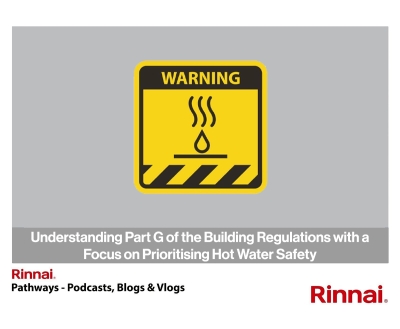In the UK, Part G of the Building Regulations and its approved documents governs the design and installation of water systems in buildings, ensuring water safety, water efficiency, and hygiene.
While it covers water sanitation and water efficiency, one of its most critical aspects is hot water safety. This area of concern affects both residential buildings and commercial properties across a spectrum for hot water usage areas from food preparation areas, washing facilities, and hot water supply for general ablutions.
Why Hot Water Safety Is a Priority Within Approved Document G
Injuries from scalding events from hot water supply are more common than many realise.
According to the Royal Society for the Prevention of Accidents (RoSPA):
- Over 2,000 people are admitted to hospital each year in the UK due to serious scalds from hot tap water supply.
- Children under five account for nearly 50% of these injuries.
- Water at 60°C can cause a third-degree burn in just 5 seconds, and at 70°C, in less than 1 second.
These figures highlight the importance of regulating hot water temperatures in residential buildings and care environments.
Safety Requirements in Approved Document G
1. Temperature Limits
Hot water delivered to baths will not exceed 48°C, enforced through thermostatic mixing valves (TMVs).
2. System Safety Features
Unvented systems must include:
- Temperature and pressure relief valves
- Expansion vessels
- Discharge pipes for safe pressure release
3. Competent Installation
Hot water systems must be installed by qualified professionals following British Standards and manufacturer guidelines.
4. Maintenance Protocols
Routine checks of TMVs, insulation, and pressure relief mechanisms are essential for ongoing safety.
Best Practices for Hot Water Systems
To go beyond compliance and ensure optimal safety and performance, consider these best practices:
1. Use Thermostatic Mixing Valves (TMVs) Throughout
Install TMVs not just in baths, but also in showers and sinks and sanitary conveniences especially in environments with vulnerable users (e.g., care homes, schools).
2. Regular Temperature Testing
Periodic temperature checks at outlets should be conducted to ensure water does not exceed safe limits. These results need to be documented for compliance audits.
3. Schedule Preventive Maintenance
A maintenance schedule should be created for:
- TMV calibration
- Inspection of pressure relief valves
- Flushing systems to prevent scale and sediment buildup
4. WRAS-Approved Components
Ensure all components are Water Regulations Advisory Scheme (WRAS) approved to guarantee quality and compliance.
5. Train Staff and Occupants
Educate building users and maintenance teams on safe water usage, signs of malfunction, and emergency procedures.
6. Keep Detailed Records
Maintain logs of installations, inspections, repairs, and temperature readings. This supports legal compliance and risk management.
Why Rinnai Continuous Flow Water Heaters are a Smart Choice
In the context of Part G compliance, Rinnai’s continuous flow water heaters offer a modern, efficient, and safe solution for hot water delivery:
Precise Temperature Control
Rinnai units allow for pre-set temperature limits, ensuring water never exceeds safe thresholds ideal for meeting the 48°C requirement for baths and reducing scalding risk.
On-Demand Heating
Unlike traditional storage systems, Rinnai water heating systems only heat water when needed, eliminating the risk of overheating and reducing energy waste and improving water efficiency.
Find out more about Rinnai water heaters today.
Energy and Water Efficiency
These systems are highly efficient by instantly heating the cold water supply, which is a necessity in heating water for Part G.
The Rinnai system also supports the reduction in water consumption and energy conservation goals of Part G while lowering operational costs, as Rinnai water heaters only heat water when it is needed.
Compact and Scalable Design
Rinnai units are modular and space-saving, making them a suitable hot water system for everything from single dwellings to large-scale commercial applications. Their diminutive size also supports reduced building work in retrofit applications.
Low NOx Emissions
Rinnai’s low NOx models contribute to better indoor air quality and environmental compliance, aligning with broader sustainability objectives.
Built-In Safety Features
Features such as overheat protection, frost protection, and flame failure detection provide additional layers of safety beyond regulatory minimums.
Legal and Operational Implications and Building Regulations Part G
For professionals in operations and facilities management, ensuring compliance with Building Regulations Part G is not just a legal requirement - it’s a duty of care. Failure to comply can result in:
- Legal action and fines
- Insurance complications
- Reputational damage
- Increased liability in the event of injury
Future Outlook
With the Building Safety Regulator now overseeing compliance under the Building Safety Act 2022, enforcement of hot water safety standards is expected to become more rigorous.
Staying ahead of these changes is essential for maintaining safe, compliant, and future-ready buildings.
Subscribe to the Rinnai newsletter and don't get left behind.
